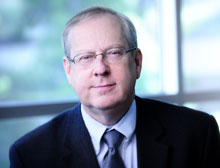The Dividing Line of Trauma
As early as 1960, “it was recognized that if you compared the two main classes of antidepressant medications available at that time, the characteristics of people who responded to the first were very different from those who responded to the second,” says Shelton. “Today we understand that these are really different conditions.”
Research in the labs of Shelton and Merida Grant, Ph.D., an assistant professor in the Department of Psychiatry, “has shown that you can divide the depression world between people who have had severe early trauma—early childhood abuse, for example—and those who haven’t.”
Somewhere around 30 percent of people with depression have had severe early-life trauma, says Shelton. “These folks are generally much more distressed,” he says. “They’re fearful and anxious, whereas the majority of people with depression, the other two-thirds or so, have a very different symptom picture. For them, the major symptoms are a flat, low mood; an inability to experience pleasure; and an inability to motivate themselves to do things that they otherwise would enjoy.”
The difference is clear in studies by Grant and other researchers that have used brain scans to segment patients with depression, Shelton says. “If you look at brain activation patterns using MRI, the scans for patients with trauma-associated depression and those with non-trauma-associated depression are almost in direct opposition to each other,” he explains. “We’d like to understand that better and then better match the existing treatments to people who are depressed or, alternatively, develop new therapies to target people with specific characteristics. To me, that’s the future of research in depression.”
Old Drugs, New Uses
 Richard Shelton is exploring new fast-acting therapies that may be especially useful for patients experiencing suicidal depression.
Richard Shelton is exploring new fast-acting therapies that may be especially useful for patients experiencing suicidal depression.
When depression strikes, physicians have no good options for quick relief. It usually takes weeks for new medicines to have an effect, a period that can be an emotional roller coaster for patients sifting each new hint of a change in mood to see if it is real and lasting.
Sometimes the wait is just too long. “Trauma-associated depression is associated with a higher risk of suicide,” Shelton explains. That’s why researchers from UAB, in collaboration with the Massachusetts General Hospital in Boston, are pursuing a new collaboration to test a rapid treatment approach. “We’re going to try to help people recover as quickly as possible,” says Shelton. “Instead of having to wait three or four weeks to get less depressed, you might only have to wait three or four hours.”
The first medication under investigation, scopolamine, isn’t new. In fact, it is a key ingredient in some motion sickness patches. “About eight years ago, doctors observed that if people were given scopolamine for other indications, their mood would come up quickly,” Shelton says. “If you give a larger amount of scopolamine through IV infusion, over a short period of time, you can get a rapid antidepressant response that seems to be sustained for weeks at a time, even after the drug is clearly gone from the patient’s system.” Earlier studies suggest that about three-quarters of people with depression will respond to scopolamine treatment. The group also plans to study other medications for rapid relief of depression.
In another project, Shelton and Cheryl McCullumsmith, M.D., Ph.D., an assistant professor of psychiatry at UAB, are leading a study investigating whether the anesthetic medication ketamine can rapidly elevate the moods of patients who arrive in emergency departments in a suicidal state. “We know that if we can get people significantly better in a short period of time and then give other treatments a chance to work, we might actually be able to reduce suicidal potential,” Shelton says. (For more, see separate article, “A New View of Suicide.”)
A New Target
The “other treatments” Shelton mentions aren’t just slightly better versions of current drugs. “It’s pretty clear that the SSRI and SNRI category is pretty much exhausted at this point,” he says. “We’re focusing instead on novel approaches, and the most promising candidates target a brain chemical called glutamate.”
Glutamate is a neurotransmitter, like serotonin and norepinephrine, Shelton explains. “It has been implicated in the regulation of mood for a long time, but we haven’t had very good treatments that target glutamate until recently.” These new drugs block glutamate from activating what are called NMDA receptors in the brain. Ketamine and other drugs, including PCP and methadone, also target NMDA receptors, but the new drugs for depression work in subtler ways, avoiding the side effects of those chemicals by targeting either the NMDA receptor or others such as the mGluR-5, Shelton says.
The new drugs are also available in tablet form, which means they do not produce the rapid reactions seen in ketamine, but they are more amenable to regular use. “We would like to test the idea of giving someone a rapid ketamine infusion in the emergency room and then starting him or her on oral medications to see if we can sustain that effect over time,” Shelton says. “This is a brand-new chemical system that appears to be very promising in depression treatment—and is totally unrelated to current medications.”
That doesn’t mean that SSRIs will go away, Shelton notes. “If you think of depression as a pie diagram, there will still be a portion of people who respond to SSRIs, and then there will be people who respond to these glutamate drugs, and I believe that will be a larger piece of the pie.” That will still leave “a residual group of people who don’t respond to either set of drugs,” Shelton adds. “So we’re going to continue to pursue new treatments until we get to 100 percent.”
UAB psychiatrist Richard Shelton explains how diet may be a key factor in preventing depression in the first place in the second part of this feature.